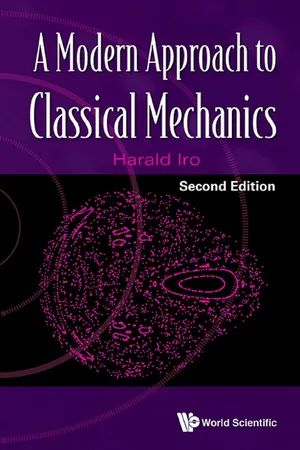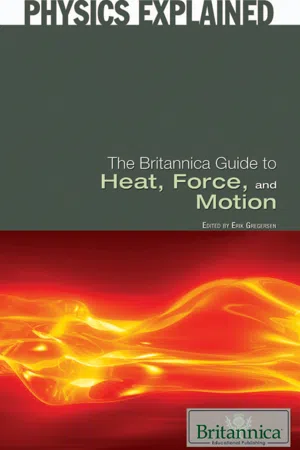Physics
Motion in One Dimension
Motion in one dimension refers to the movement of an object along a straight line. It is described using concepts such as displacement, velocity, and acceleration. The study of motion in one dimension helps in understanding the behavior of objects in terms of their position, speed, and changes in speed over time.
Written by Perlego with AI-assistance
Related key terms
8 Key excerpts on "Motion in One Dimension"
- eBook - ePub
Classical Mechanics
A Computational Approach with Examples Using Mathematica and Python
- Christopher W. Kulp, Vasilis Pagonis(Authors)
- 2020(Publication Date)
- CRC Press(Publisher)
CHAPTER 2Single-Particle Motion in One DimensionIn this chapter, we will examine one-dimensional motion, i.e., motion along a line. It is sometimes the case that a particle’s motion need only to be described along one direction. Furthermore, a careful study of one-dimensional motion will be a useful foundation for understanding more general motion in higher dimensions. In this chapter, we will give several examples of solving Newton’s second law, F = ma in one dimension. We will consider several types of forces: both constant and those which depend on time F(t), velocity F(v), and position F(x). In addition, we will discuss and demonstrate two different uses of computers to solve physics problems: how to use computer algebra systems (CAS) to obtain the analytical solutions of Newton’s second law, and how to obtain numerical solutions of ordinary differential equations (ODE) using software packages and by using the Euler method.2.1Equations of motionTo begin our study of one-dimesional motion, we first need to make some assumptions about the object whose motion we are examining. One fundamental assumption in this chapter is that the object being studied is a point particle. In order to mathematically describe the motion of a particle under the influence of a force, we need to find the particle’s equations of motion. The equations of motion of a particle are the equations which describe its position, velocity, and acceleration as a functions of time. Equations of motion can be in the form of algebraic equations, or in the form of differential equations.As we will see, the equations of motion of a particle can be found by solving Newton’s second law as a differential equation. In this chapter, we will focus on one-dimensional motion, where the force vector and the particle’s displacement are along the same line (but not necessarily in the same direction—the direction could be horizontal or vertical). Because all vectors in a given problem lay along the same line, we drop the vector notation in all the equations. A negative sign between two quantities will denote vectors that lay in opposite directions along the same line. - eBook - ePub
Doing Physics with Scientific Notebook
A Problem Solving Approach
- Joseph Gallant(Author)
- 2012(Publication Date)
- Wiley(Publisher)
Chapter 2One-Dimensional Kinematics
We start Doing Physics with SNB in the branch of physics known as Classical Mechanics. Our study of Classical Mechanics begins with one-dimensional kinematics, the description of motion in a straight line. This includes horizontal motion to the right or left and vertical motion straight up or down. This description will tell us where an object is, where it is going, and how much time it took to get there.Constant Acceleration
Studying motion with a constant acceleration is a good place to start. We can describe this motion completely without using calculus. Let’s start with some definitions and important distinctions, and then we’ll solve some one-dimensional problems.Displacement and Position
To describe an object’s motion, we need to establish a coordinate system so we can specify location. For 1-dimensional motion the coordinate system is just the x-axis with the origin at x = 0 and positive values to the right. The object’s position, specified by its x-coordinate, tells us how far from the origin it is and in which direction.The displacement is the object’s change in position.(2.1)This difference between the object’s final and initial position tells us how far from its original position it ends. A positive displacement means the object ends to the right of x0 and a negative displacement means the object ends to the left of x0 . For a round trip, the initial and final positions are equal and the displacement is zero. The SI unit for both position and displacement is the meter (m).Note The use of the upper case Greek letter delta (“Δ”) to mean “change in” is standard mathematical notation, but it has no special significance in SNB. In a calculation, SNB interprets the expression Δf as Δ x f, the product of two variables.Even though they have the same unit, displacement and distance are different. Suppose you start 2 meters from the origin, walk 9 meters to the right, turn around and walk 5 meters back toward the origin. Your initial position was x0 = 2 m and your final position is x = 6m, so your displacement is Δx - eBook - ePub
- Harald Iro(Author)
- 2015(Publication Date)
- WSPC(Publisher)
3One-dimensional motion of a particle
The simplest system consists of a single particle whose motion only has one degree of freedom. In the following, we investigate the constants of the motion and the conserved quantities for Newton’s equation in one dimension. Since the representation in phase space here is two-dimensional, the particle’s motion in phase space can be visualized graphically.3.1 Examples of one-dimensional motion
Figure 3.1: The inclined track.i) The inclined track: A particle of mass m slides without friction on a track inclined at angle α to the direction of the gravitational force F = mg. Since forces obey vector addition (see Page 17), the force of gravity can be split into components parallel and perpendicular to the track1 :where (see Fig. 3.1 )Motion along the track is influenced only by F|| ; the perpendicular component F is exactly counterbalanced by the track2 (see Fig. 3.1 ). Let s be the distance along the track (with respect to some initial point s0 = 0). The momentum of the particle is p = m . Hence, the equation of motion isFigure 3.2: The plane pendulum.Figure 3.3: An oscillating mass.ii) The plane mathematical pendulum: A particle of mass m is attached to the end of a massless bar of length l that can swing freely about a fixed point. The particle is pushed such that its motion always remains in the plane (i.e. the initial velocity vector lies in the plane containing the bar and gravitational force vector). Since lϕ is the arclength, where ϕ is the angle between the bar and the vertical, the equation of motion reads (see also Section 3.3.2 below):iii) The harmonic oscillator: A particle of mass m is confined to move along the x-axis. It is attached to a spring, with equilibrium position xequ. Assume that the spring obeys Hooke’s Law, |F| ∝ |x − xequ|, meaning that the force is harmonic, i.e. it is given by F = −k(x − xequ). If xequis chosen as the origin, i.e. xequ - eBook - ePub
- Michael M. Mansfield, Colm O'Sullivan(Authors)
- 2020(Publication Date)
- Wiley(Publisher)
4 Motion in two and three dimensionsAIMS
- to show how, in two and three dimensions, physical quantities can be represented by mathematical entities called vectors
- to rewrite the laws of dynamics in vector form
- to study how the laws of dynamics may be applied to bodies which are constrained to move on specific paths in two and three dimensions
- to describe how the effects of friction may be included in the analysis of dynamical problems
- to study the motion of bodies which are moving on circular paths
4.1 Vector physical quantities
The material universe is a three‐dimensional world. In our investigation of the laws of motion in Chapter 3 , however, we considered only one‐dimensional motion, that is situations in which a body moves on a straight line and in which all forces applied to the body are directed along this line of motion. If a force is applied to a body in a direction other than the direction of motion the body will no longer continue to move along this line. In general, the body will travel on some path in three‐dimensional space, the detail of the trajectory depending on the magnitude and direction of the applied force at every instant. Equation (3.3) as it stands is not sufficiently general to deal with such situations, for example the motion of a pendulum bob (Figure 4.1 ) or the motion of a planet around the Sun (Figure 4.2 ). Newton's second law needs to be generalised from the simple one‐dimensional form discussed in Chapter 3 .A pendulum comprising a mass attached to the end of a string; the mass can move on a path such that the distance from the fixed end of the string remains constant.Figure 4.1A similar problem arises if two or more forces act on a body simultaneously, for example when a number of tugs are manoeuvring a large ship (Figure 4.3 - David V. Guerra(Author)
- 2023(Publication Date)
- CRC Press(Publisher)
Kinematics, first developed by Galileo, is the formal study of the motion of objects using diagrams, graphs, and equations. In the previous chapters, the analysis employed assumed the objects were either at rest or moving at a constant speed. Situations under these conditions are known as a static, because the forces are balanced. When the forces become unbalanced, accelerated motion results. In this chapter, the terminology used to describe all types of motion is formalized in preparation for subsequent chapters in which the resulting motion of unbalanced force will be studied. This chapter will start with a definition of displacement and then explore velocity and acceleration in both graphical and analytical formats. It is important to realize that the problem-solving techniques employed in this chapter are different than those used in the previous and subsequent chapters, and this is only a brief aside to introduce the terminology and practices of kinematics.- Displacement: The displacement (of an object is the change in position of an object relative to a fixed origin, as described in Figure 7.2 .d ⇀)FIGURE 7.2 Definition of displacement.Displacement is a vector. Suppose that at time t0 , a particle is at position(relative to the origin of an x-y coordinate system), and at time t1 , the particle is at positionr ⇀0The displacement that the particle undergoes from time t0 to time t1 is then given in equation (7.1) as:.r ⇀1The SI unit for the magnitude of the displacement vector is the meter (m).(7.1)=d ⇀01−r ⇀1r ⇀0As an example of a displacement, as depicted in Figure 7.3 , at time t0 a man is 5 m east of a lamppost and is walking directly away from the lamppost so that he is 15 m east of the lamppost at time t1 . His displacementfrom time t0 to time t1 would be 10 m eastward.d ⇀01FIGURE 7.3 Displacement example.
- Velocity: In previous chapters, the velocity (of an object was defined as the speed of the object and the direction in which the object is moving. This definition is more precisely known of the instantaneous velocity of an object, to distinguish it from the average velocity over a known time interval. The average value-with-direction of the velocityv ⇀)v ⇀over some time interval, from time t0 to time t1 , is shown in equation (7.2) and obtained by dividing the total displacementthat occurs during that time interval by the duration of the time interval t01 = t1 − t0 :d ⇀01The SI unit for velocity is the meter per second (m/s).(7.2)=v ⇀Avg01 s / d ⇀01t 01For example, if the man in the previous example, shown in Figure 7.3
- eBook - ePub
Introductory Physics
Summaries, Examples, and Practice Problems
- Michael Antosh(Author)
- 2023(Publication Date)
- CRC Press(Publisher)
Motion in Two and Three DimensionsDOI: 10.1201/9781003005049-33.1 Introduction: Three Dimensions Are More Realistic Than One
Chapter 2 was all about Motion in One Dimension, which means that all of the motion was along a straight line. Sometimes this works just fine, like a straight road. But in general, we need more than one dimension to accurately describe motion. In this chapter, we’ll use similar strategies to Chapter 2 for situations where the motion is not in a straight line.3.2 Dimensions Behave Separately
From where you are, right now, you can describe the space around you using a combination of three directions:- Up/down
- Left/right
- Forward/backward
These directions are what we call dimensions. Left/right is often called “the x direction” in physics. Up/down is often called “the y direction”. Forward/backward is often called “the z direction”. Which directions are called x, y, and z can be different, and they don’t have to be exactly these definitions.When we look at motion in three dimensions for this course, the motion actually behaves like three separate motion problems, with each one similar to the problems in Chapter 2 : a problem in the x direction, a problem in the y direction, and a problem in the z direction. This may not seem obvious at first.A classic physics class demonstration shows the dimensions behaving separately during motion. The demonstration starts with a contraption holding two identical balls at exactly the same height. When the teacher presses a button, both of the balls start moving at exactly the same time. One of the balls is dropped straight downward (call it the –y direction), while the second ball goes sideways (call it the +x direction). There are two results of this motion: - No longer available |Learn more
MCAT Physics and Math Review 2024-2025
Online + Book
- (Author)
- 2023(Publication Date)
- Kaplan Test Prep(Publisher)
Now that we’ve covered the basic geometry that serves as the foundation of physics, we can examine the related physical quantities. The basic quantities that relate to kinematics are displacement, velocity, and acceleration.Displacement
An object in motion may experience a change in its position in space, known as displacement (x or d). This is a vector quantity and, as such, has both magnitude and direction. The displacement vector connects (in a straight line) the object’s initial position and its final position. Understand that displacement does not account for the actual pathway taken between the initial and the final positions—only the net change in position from initial to final. Distance (d) traveled, on the other hand, considers the pathway taken and is a scalar quantity.Example:What is the displacement of a person who walks 2 km east, then 2 km north, then 2 km west, and then 2 km south?Solution:While the total distance traveled is 8 km, the displacement is a vector quantity that represents the change in position. In this case, the displacement is zero because the person ends up back at the start, as shown below.Velocity
As was mentioned earlier, velocity (v) is a vector. Its magnitude is measured as the rate of change of displacement in a given unit of time, and its SI units are meters per second. The direction of the velocity vector is necessarily the same as the direction of the displacement vector. Speed (v) is the rate of actual distance traveled in a given unit of time.The distinction is subtle, so let’s examine this a little more carefully. The instantaneous speed of an object will always be equal to the magnitude of the object’s instantaneous velocity, which is a measure of the average velocity as the change in time (Δt) approaches zero:v =Equation 1.6limΔ t → 0Δ xΔ twhere v is the instantaneous velocity, Δx is the change in position, and Δt - eBook - ePub
- Britannica Educational Publishing, Erik Gregersen(Authors)
- 2010(Publication Date)
- Britannica Educational Publishing(Publisher)
Resonances are not uncommon in the world of familiar experience. For example, cars often rattle at certain engine speeds, and windows sometimes rattle when an airplane flies by. Resonance is particularly important in music. For example, the sound box of a violin does its job well if it has a natural frequency of oscillation that responds resonantly to each musical note. Very strong resonances to certain notes—called “wolf notes” by musicians—occur in cheap violins and are much to be avoided. Sometimes, a glass may be broken by a singer as a result of its resonant response to a particular musical note.MOTION OF A PARTICLE IN TWO OR MORE DIMENSIONS
More complex problems in mechanics involve a particle moving in two or more dimensions. Such problems include those of the pendulum and the circular orbit.PROJECTILE MOTIONGalileo pointed out with some detectable pride that none before him had realized that the curved path followed by a missile or projectile is a parabola. He had arrived at his conclusion by realizing that a body undergoing ballistic motion executes, quite independently, the motion of a freely falling body in the vertical direction and inertial motion in the horizontal direction. These considerations, and terms such as ballistic and projectile, apply to a body that, once launched, is acted upon by no force other than Earth’s gravity.Projectile motion may be thought of as an example of motion in space—that is to say, of three-dimensional motion rather than motion along a line, or one-dimensional motion. In a suitably defined system of Cartesian coordinates, the position of the projectile at any instant may be specified by giving the values of its three coordinates, x (t ), y (t ), and z (t ). By generally accepted convention, z (t ) is used to describe the vertical direction. To a very good approximation, the motion is confined to a single vertical plane, so that for any single projectile it is possible to choose a coordinate system such that the motion is two-dimensional [say, x (t ) and z (t )] rather than three-dimensional [x (t ), y (t ), and z (t
Index pages curate the most relevant extracts from our library of academic textbooks. They’ve been created using an in-house natural language model (NLM), each adding context and meaning to key research topics.







